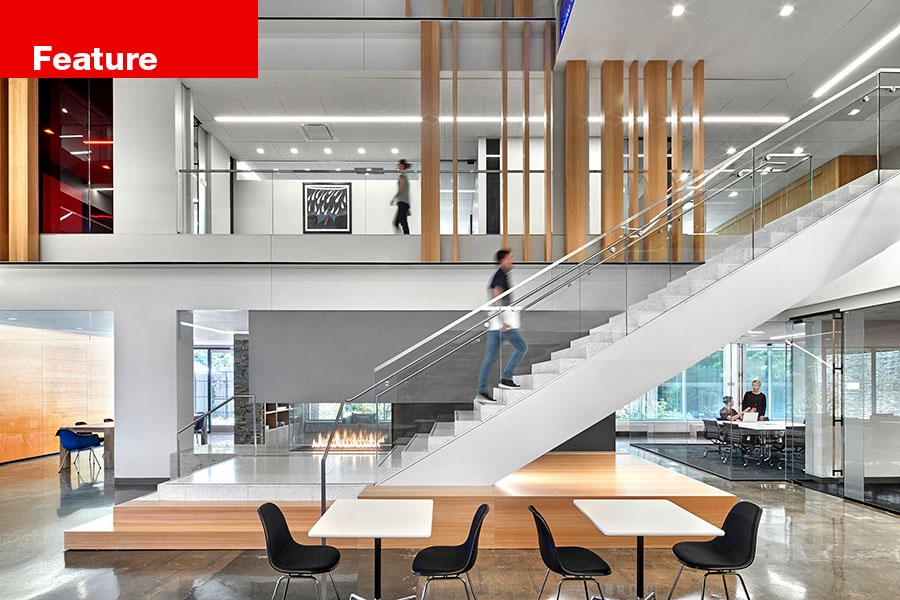Expect post-pandemic office design to feature accelerated tech, more collaboration spaces and built-world responses to the touchstones of 2020.
PaperCut takes its company culture very seriously.
Headquartered in Melbourne, Australia, the print management software firm has offices in London and, until last year, Portland’s Goose Hollow neighborhood. In March 2020, it expanded its Portland operations, leasing 15,000 square feet in Old Town for its 25 on-site employees and 10 remote workers, called “remotees,” in delightful Australian fashion, according to head of Americas region director Dave Farrell.
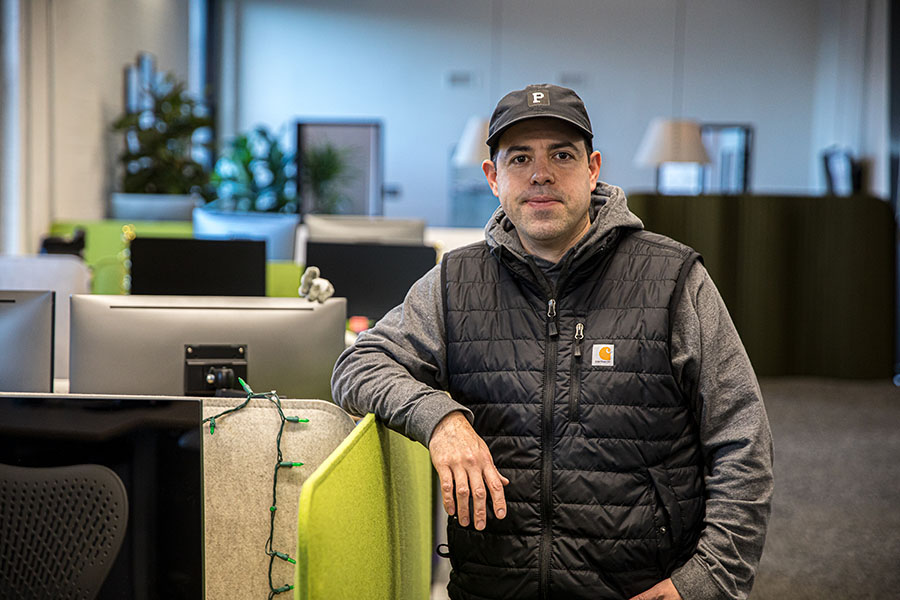 Dave Farrell, head of Americas region for PaperCut Photo: Jason E. Kaplan
Dave Farrell, head of Americas region for PaperCut Photo: Jason E. Kaplan
“That office’s design aligns closely to our culture,” he says, pointing to a ping-pong table and a fancy Italian espresso machine. “Every employee goes through a full day of barista training.”
Aside from caffeine-fueled fun, PaperCut’s new office design expresses its culture of collaboration, as evidenced by large space designed to accommodate a weekly, all-hands-on meeting that spans the globe.
“We have two 100-inch televisions in that main area with integrated microphones and touchscreen pads,” he says. “The effect is almost like all 220 employees are in the same room.”
If, of course, employees could be in the same room.
As of March 12, 2020, all of PaperCut’s employees are “remotees,” despite moving into their new space in late November of 2020. They still manage to collaborate, of course. Work from home brought virtual meetings, Google Hangouts and Zoom cocktail parties galore. But the face-to-face, idea-generating, spontaneous gatherings that fuel creativity remain on hold.
All while PaperCut’s brand-new, culture-affirming office sits empty.
RELATED STORY: Embracing the Hybrid Workforce
The same scene is playing out across the world. Office managers and employees all wonder what work will look and feel like as we emerge from our homes and make our way back to the office. Meanwhile, interior designers and architects are rethinking office spaces in response to the pandemic.
These past 10 months revealed some important lessons. People love working from home and they hate working from home. Productivity in its purest, heads-down, on-task sense improved during this time while connection to company culture and the ability to mentor and network weakened. Collaboration, as a cornerstone of creativity, was, is and will remain king.
But no one knows for sure how these post-pandemic truths will influence office design in the years to come. Or if we will really need that much space at all.
“Everyone is gazing into the same crystal ball,” says Matt Johnson, executive managing director of commercial real estate services firm Cushman & Wakefield. He acknowledges that working from home, at least part of the time, will continue. Johnson also admits that a lot of unused office space hit the sublease market during the pandemic. Still, he does not predict a mad rush to unload square footage in the coming years.
“Having half of your employees working from home does not directly translate into needing 50% less office space,” he argues.
Melissa Mizell, design director and principal with Gensler, agrees. “We do not see offices shrinking dramatically,” she says. “But how we use that space is going to change.” Mizell predicts more square footage will be devoted to collaborative spaces that enhance and encourage face-to-face interactions.
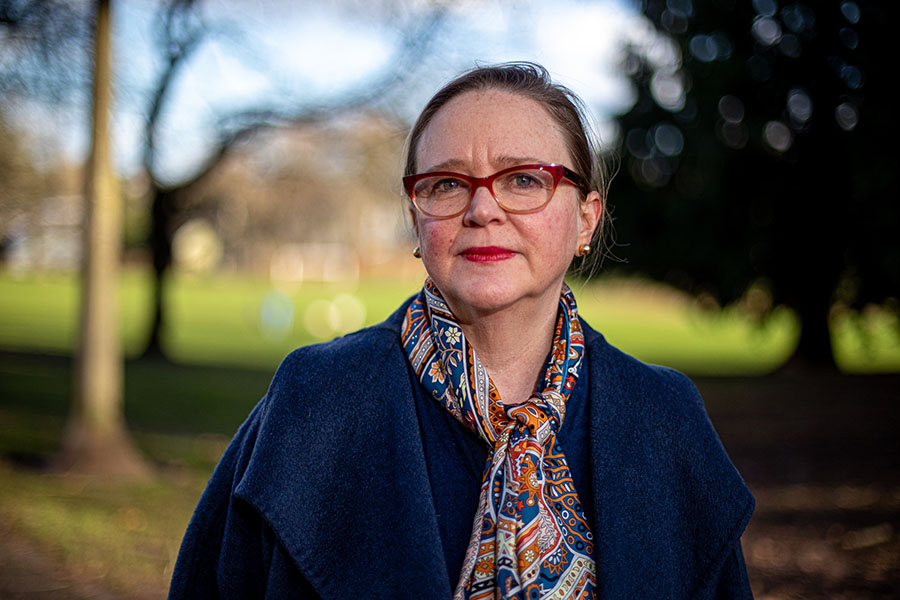 Melissa Mizell, design director and principal, Gensler. Photo: Jason E. Kaplan
Melissa Mizell, design director and principal, Gensler. Photo: Jason E. Kaplan
Of course, collaborative spaces are nothing new. Office design, particularly for creative and high-tech companies, moved past offering one or two formal conference rooms long ago. Instead, contemporary, open-plan layouts scatter these meeting areas throughout the space. Think larger desks for impromptu one-on-ones, casual breakout areas furnished with soft seating and whiteboards, in-house cafes that mimic a coffeehouse vibe and even outdoor areas all designed to encourage collaborative work.
Mizell expects that already embedded trend to accelerate, even as employees continue to work from home a few days a week. “It is about the ability to pick your work environment,” she says. “After all, working from home is not ideal for everybody at all times.”
In fact, the ability to work from home successfully is a privilege. Senior employees with established professional networks, larger homes and mostly grown children enjoy long stretches of uninterrupted productivity, according to Cushman & Wakefield’s Johnson. “Senior clients tell me that they get so much done because no one interrupts them 15 times a day,” he explains.
But the flip side reveals a younger workforce struggling to cope.
Johnson notes that this cohort likely shares smaller homes (and Wi-Fi) with a roommate or two, or cares for small children while still trying to work. “This group does not have the same institutional knowledge, and they are missing out on that mentoring — those 15 interruptions a day — from senior employees.”
This has organizations reevaluating when and, more important, why employees need to be in the office. “Maybe people will come in two or three days a week for meetings or specific projects,” says Sharron van der Meulen, managing partner, ZGF Architects. “Or for that touchpoint of social and cultural engagement.”
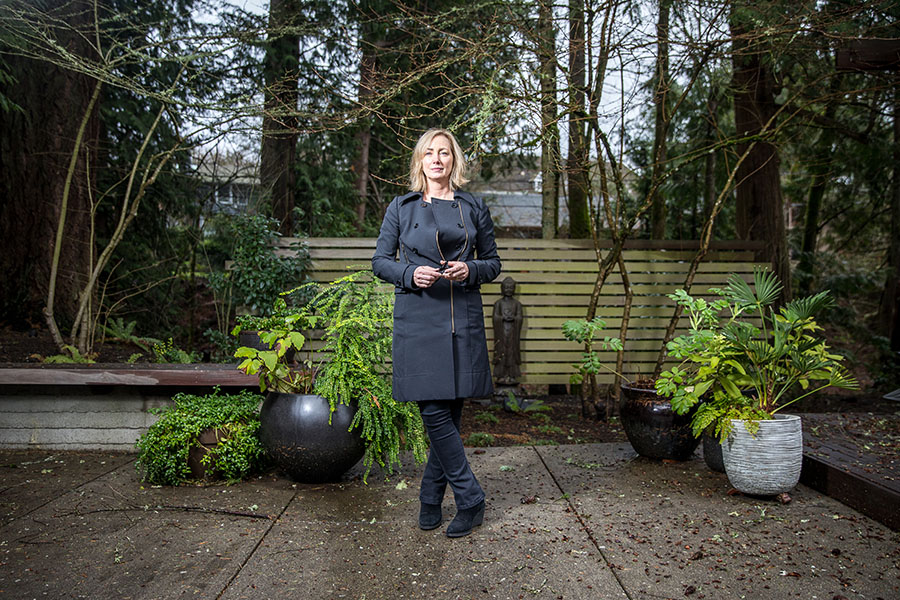 Sharron van der Meulen, managing partner, ZGF Architects. Photo: Jason E. Kaplan
Sharron van der Meulen, managing partner, ZGF Architects. Photo: Jason E. Kaplan
This will lead to a demand for even more flexible space and furnishings. “Do not confuse flexibility with adjustable chairs or sit-stand desks,” cautions ZGF Architects principal Alan Gerencer. The term refers to modular furniture that can expand and recede as needed, and spaces that can morph to fit immediate needs.
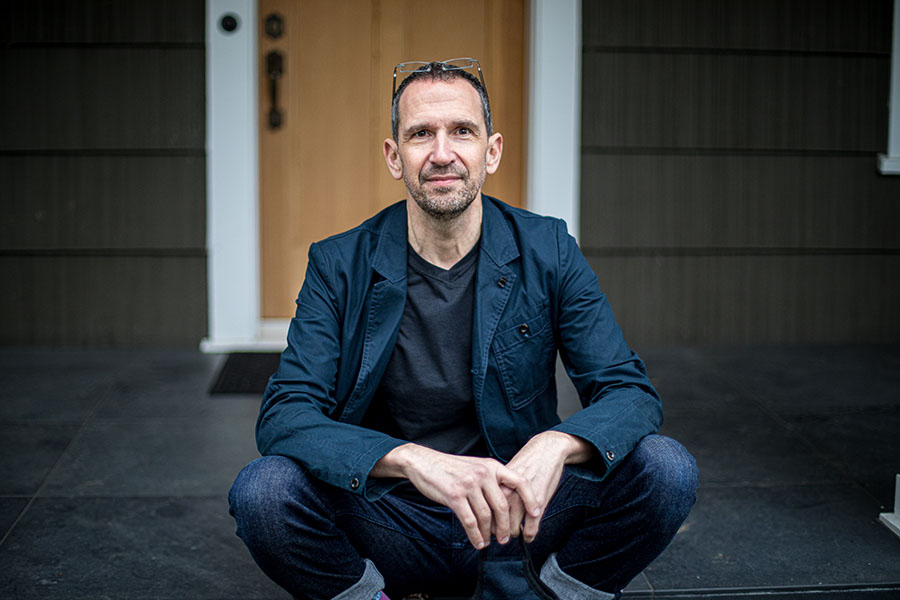 Alan Gerencer, principal, ZGF Architects. Photo: Jason E. Kaplan
Alan Gerencer, principal, ZGF Architects. Photo: Jason E. Kaplan
He also notes that flexibility will be a necessary state of mind as we get back into the office. “We were thrown into this situation quickly,” he says. “Coming back will be gradual and require trust and flexibility.”
Expect some tangible, physical changes to help ease the transition.
Employees will want more space and confidence in the cleanliness of that space. Because of this, hot desking, where workers pop in and set up at any available desk, may morph into a more organized, reservation-based system of hoteling.
Say goodbye to work benches, where employees sit elbow-to-elbow on either side of a long table. Large, in-house cafes will remain important gathering spaces, but do not expect to hang out and work there all day. Instead, there may be an occupancy management system that limits and controls usage.
And get ready for more technology everywhere in the space. Tech promises to not only allow for continued collaboration but act as an equalizing force promoting parity over hierarchy.
RELATED STORY: The End of 9 to 5
Imagine, for instance, a conference room specifically designed for hybrid meetings, or removing the home-office advantage and having insightful conversations with colleagues across multiple locations. ZGF Architects’ van der Meulen reports this equalization as a plus. “It does not matter where you are,” she says. “It feels like we are working as one big firm.”
Even something as ordinary as grabbing a casual, on-site lunch could be enhanced by tech that seamlessly beams work-from-home employees to a table-side screen.
Behind-the-scenes tech, in the form of building mechanicals and HVAC systems, will become more important as well. Extra attention will be paid to air filters, isolated ducts and increased outside air. Working windows will feel like a luxury.
But the success of the future office, and our comfort in it, is not all about technology.
In fact, expect quite the opposite. The physical manifestation of health and wellness, a long-standing commercial interior design trend, will continue renewed and elevated. This means incorporating more biophilic design, which stresses a deeper connection to the natural world. Elements like wood, running water and natural light will play a strong role in bringing people back comfortably.
This idea is not new. The early 20th century’s Modernist movement, with its clean lines and lack of ornamentation, was a direct response to that era’s waves of cholera, tuberculosis and flu pandemics. These designers also prized natural light, fresh air and proximity to nature for their healing effects.
As all-encompassing as the pandemic was and still is, many other cultural touchstones arose during 2020. Expect design to honor, examine and incorporate these influences as well. “Social justice awareness; the importance of diversity, equity and inclusion; and the #MeToo movement impact every person in our office,” explains ZGF Architects’ Gerencer. “It will impact how we approach future projects as well.”
Meanwhile, Farrell cannot wait to get back to PaperCut’s new office. Managers plan to let people work from home on Monday and Friday and reserve the middle of the week for collaborative project work. They have no plans to reconfigure or downsize their space.
“Our path is to be together and we are going back to that mindset,” he says.
To subscribe to Oregon Business, click here.


